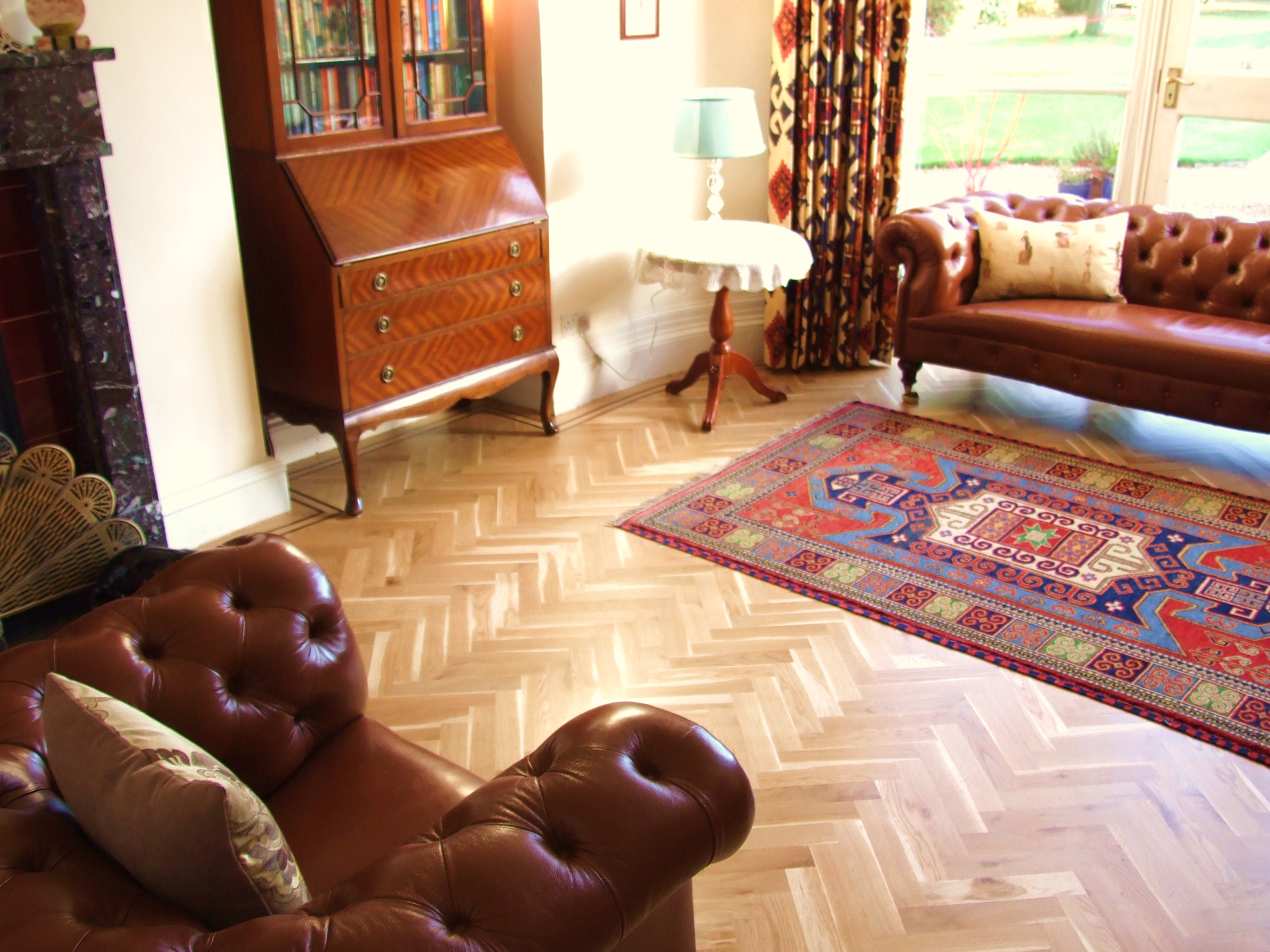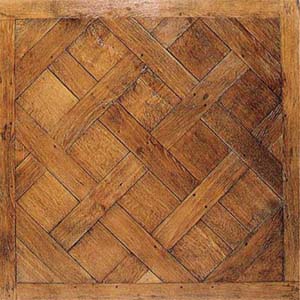|
Flooring
Flooring is the general term for a permanent covering of a floor, or for the work of installing such a floor covering. Floor covering is a term to generically describe any finish material applied over a floor structure to provide a walking surface. Both terms are used interchangeably but floor covering refers more to loose-laid materials. Materials almost always classified as flooring include carpet, laminate, tile, and vinyl. Subfloor The floor under the flooring is called the subfloor, which provides the support for the flooring. Special purpose subfloors like floating floors, raised floors or sprung floors may be laid upon another underlying subfloor which provides the structural strength. Subfloors that are below grade (underground) or ground level floors in buildings without basements typically have a concrete subfloor. Subfloors above grade (above ground) typically have a plywood subfloor. Flooring materials The choice of materials for floor covering is affected by ... [...More Info...] [...Related Items...] OR: [Wikipedia] [Google] [Baidu] |
Laminate Flooring
Laminate flooring (also called floating wood tile in the United States) is a multi-layer synthetic flooring product fused together with a lamination process. Laminate flooring simulates wood (or sometimes stone) with a photographic appliqué layer under a clear protective layer. The inner core layer is usually composed of melamine resin and Fiberboard, fiber board materials. There is a European Standard NoEN 13329:2000specifying laminate floor covering requirements and testing methods. Laminate flooring has grown significantly in popularity, perhaps because it may be easier to install and maintain than more traditional surfaces such as Wood flooring, hardwood flooring. It may also have the advantages of costing less and requiring less skill to install than alternative flooring materials. It is reasonably durable, Hygiene, hygienic (several brands contain an antimicrobial resin), and relatively easy to maintain. Installation Laminate floors are reasonably easy for a do it yours ... [...More Info...] [...Related Items...] OR: [Wikipedia] [Google] [Baidu] |
Wood Flooring
Wood flooring is any product manufactured from timber that is designed for use as flooring, either structural or aesthetic. Wood is a common choice as a flooring material and can come in various styles, colors, cuts, and species. Bamboo flooring is often considered a form of wood flooring, although it is made from bamboo rather than timber. Types Solid Hardwood flooring Solid hardwood floors are made of planks milled from a single piece of timber. Solid hardwood floors were originally used for structural purposes, being installed perpendicular to the wooden support beams of a building known as joists or bearers. With the increased use of concrete as a subfloor in some parts of the world, engineered wood flooring has gained some popularity. However, solid wood floors are still common and popular, but are commonly more expensive in the United States and considered higher end. Solid wood floors have a thicker wear surface and can be sanded and finished more times than an ... [...More Info...] [...Related Items...] OR: [Wikipedia] [Google] [Baidu] |
Floor
A floor is the bottom surface of a room or vehicle. Floors vary from wikt:hovel, simple dirt in a cave to many layered surfaces made with modern technology. Floors may be stone, wood, bamboo, metal or any other material that can support the expected load. The levels of a building are often referred to as floors, although sometimes referred to as storeys. Floors typically consist of a subfloor for support and a floor covering used to give a good walking surface. In modern buildings the subfloor often has electrical wiring, plumbing, and other services built in. As floors must meet many needs, some essential to safety, floors are built to strict building codes in some regions. Special floor structures Where a special floor structure like a floating floor is laid upon another floor, both may be called subfloors. Special floor structures are used for a number of purposes: * Balcony, a platform projecting from a wall * Floating floor, normally for noise or vibration reductio ... [...More Info...] [...Related Items...] OR: [Wikipedia] [Google] [Baidu] |
Subfloor
A floor is the bottom surface of a room or vehicle. Floors vary from simple dirt in a cave to many layered surfaces made with modern technology. Floors may be stone, wood, bamboo, metal or any other material that can support the expected load. The levels of a building are often referred to as floors, although sometimes referred to as storeys. Floors typically consist of a subfloor for support and a floor covering used to give a good walking surface. In modern buildings the subfloor often has electrical wiring, plumbing, and other services built in. As floors must meet many needs, some essential to safety, floors are built to strict building codes in some regions. Special floor structures Where a special floor structure like a floating floor is laid upon another floor, both may be called subfloors. Special floor structures are used for a number of purposes: * Balcony, a platform projecting from a wall * Floating floor, normally for noise or vibration reduction * Glass f ... [...More Info...] [...Related Items...] OR: [Wikipedia] [Google] [Baidu] |
Raised Floor
A raised floor (also raised flooring, access floor(ing), or raised-access computer floor) provides an elevated structural floor above a solid substrate (often a concrete slab) to create a hidden void for the passage of mechanical and electrical services. Raised floors are widely used in modern office buildings, and in specialized areas such as command centers, Information technology data centers and computer rooms, where there is a requirement to route mechanical services and cables, wiring, and electrical supply. Such flooring can be installed at varying heights from to heights above to suit services that may be accommodated beneath. Additional structural support and lighting are often provided when a floor is raised enough for a person to crawl or even walk beneath. In the U.S., underfloor air distribution is becoming a more common way to cool a building by using the void below the raised floor as a plenum chamber to distribute conditioned air, which has been done in E ... [...More Info...] [...Related Items...] OR: [Wikipedia] [Google] [Baidu] |
Parquet
Parquet (; French for "a small compartment") is a geometric mosaic of wood pieces used for decorative effect in flooring. Parquet patterns are often entirely geometrical and angular—squares, triangles, lozenges—but may contain curves. The most popular parquet flooring pattern is herringbone. Etymology The word derives from the Old French ''parchet'' (the diminutive of ''parc''), literally meaning "''a small enclosed space''". History Large diagonal squares known as ''parquet de Versailles'' were introduced in 1684 as ''parquet de menuiserie'' ("woodwork parquet") to replace the marble flooring that required constant washing, which tended to rot the joists beneath the floors. Such ''parquets en losange'' were noted by the Swedish architect Daniel Cronström at Versailles and at the Grand Trianon in 1693. Materials Woods contrasting in color and grain, such as oak, walnut, cherry, lime, pine, maple etc. are sometimes employed, and in the more expensive kinds the ri ... [...More Info...] [...Related Items...] OR: [Wikipedia] [Google] [Baidu] |
Janka Scale
The Janka hardness test (; ), created by Austrian-born American researcher Gabriel Janka (1864–1932), measures the resistance of a sample of wood to denting and wear. It measures the force required to embed an steel ball halfway into a sample of wood. (The diameter was chosen to produce a circle with an area of 100 square millimeters, or one square centimeter.) A common use of Janka hardness ratings is to determine whether a species is suitable for use as flooring. For hardwood flooring, the test usually requires an sample with a thickness of at least 6–8 mm, and the most commonly used test is the ASTM D1037. When testing wood in lumber form, the Janka test is always carried out on wood from the tree trunk (known as the heartwood), and the standard sample (according to ASTM D143) is at 12% moisture content and clear of knots. The hardness of wood varies with the direction of the wood grain. Testing on the surface of a plank, perpendicular to the grain, is said to be ... [...More Info...] [...Related Items...] OR: [Wikipedia] [Google] [Baidu] |
Floating Floor
A floating floor is a floor that does not need to be nailed or glued to the subfloor. The term floating floor refers to the installation method, but is often used synonymously with laminate flooring. It is applied now to other coverings such as floating tile systems and vinyl flooring in a domestic context. A floating floor is a type of flooring installation method where the individual floorboards or tiles are not directly attached to the sub-floor. Instead, they are laid over a thin underlayment or foam padding, allowing them to "float" above the sub-floor. A sprung floor is a special type of floating floor designed to enhance sports or dance performance. In general though the term refers to a floor used to reduce noise or vibration. A domestic floating floor might be constructed over a subfloor or even over an existing floor. It can consist of a glass fibre, felt or cork layer for sound insulation with neoprene pads holding up a laminate floor. There is a gap between the ... [...More Info...] [...Related Items...] OR: [Wikipedia] [Google] [Baidu] |
Sprung Floor
A sprung floor is a floor that absorbs shocks, giving it a softer feel. Such floors are considered the best kind for dance and indoor sports and physical education, and can enhance performance and greatly reduce injuries. Modern sprung floors are supported by foam backing or rubber feet, while traditional floors provide their spring through bending woven wooden battens. Sprung floors have been used in dance halls and performance venues since the 19th century, and are also used in gymnastics, cheerleading, and other athletic activities that require a cushioned surface. The construction of sprung floors can vary, but they generally consist of a performance surface layer on top of a sprung sub-floor with shock-absorbing materials. Sprung floors provide benefits such as injury reduction, enhanced performance, and appropriate traction for users. One of the earliest on-record sprung-floor ballrooms is Papanti's for dance lessons in Boston, built in 1837. There was also one in the New Zea ... [...More Info...] [...Related Items...] OR: [Wikipedia] [Google] [Baidu] |
Solid Ground Floor
A solid ground floor consists of a layer of concrete, which in the case of a domestic building will be the surface layer brought up to ground floor level with hardcore filling under it. The advantage of a solid ground floor is the elimination of dry rot and other problems normally associated with hollow joisted floors. The disadvantage is that the floor is less resilient to walk upon and may be more tiring for the user. Solid ground floors are usually found or situated in a kitchen but will be necessary for other rooms where wood blocks and other similar finishes are required. Finishes Cement screed The concrete floor may be topped with a 25 mm thick cement and sand screed trowelled to a smooth finish. The usual mix is 1:3 and a colouring agent may be added to the mix to obtain a more attractive finish. The mix should be as dry as possible and the sand should be coarsely graded and clean to avoid shrinkage and cracking which might occur with a wet mix. The floor finish is ca ... [...More Info...] [...Related Items...] OR: [Wikipedia] [Google] [Baidu] |
Reclaimed Lumber
Reclaimed lumber is processed wood retrieved from its original application for purposes of subsequent use. Most reclaimed lumber comes from timbers and decking rescued from old barns, factories and warehouses, although some companies use wood from less traditional structures such as boxcars, coal mines and wine barrels. Reclaimed or antique lumber is used primarily for decoration and home building, for example for siding, architectural details, cabinetry, furniture and flooring. Wood origins In the United States of America, wood once functioned as the primary building material because it was strong, relatively inexpensive and abundant. Today, many of the woods that were once plentiful are only available in large quantities through reclamation. One common reclaimed wood, longleaf pine, was used to build factories and warehouses during the Industrial Revolution. The trees were slow-growing (taking 200 to 400 years to mature), tall, straight, and had a natural ability to resist m ... [...More Info...] [...Related Items...] OR: [Wikipedia] [Google] [Baidu] |
Hardwoods
Hardwood is wood from angiosperm trees. These are usually found in broad-leaved temperate and tropical forests. In temperate and boreal latitudes they are mostly deciduous, but in tropics and subtropics mostly evergreen. Hardwood (which comes from angiosperm trees) contrasts with softwood (which is from gymnosperm trees). Characteristics Hardwoods are produced by angiosperm trees that reproduce by flowers, and have broad leaves. Many species are deciduous. Those of temperate regions lose their leaves every autumn as temperatures fall and are dormant in the winter, but those of tropical regions may shed their leaves in response to seasonal or sporadic periods of drought. Hardwood from deciduous species, such as oak, normally shows annual growth rings, but these may be absent in some tropical hardwoods. Hardwoods have a more complex structure than softwoods and are often much slower growing as a result. The dominant feature separating "hardwoods" from softwoods is the presen ... [...More Info...] [...Related Items...] OR: [Wikipedia] [Google] [Baidu] |








